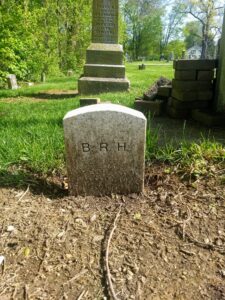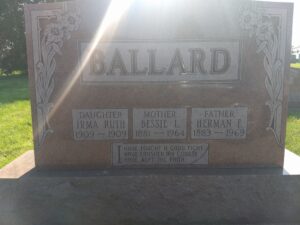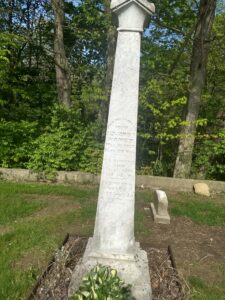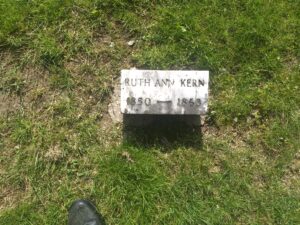I was recently asked by a family member as to whether I had a preference with respect to being either buried or cremated. My immediate response, ala Bob Hope, was “Surprise me.”
The sincere question and my flippant response brought to mind a story that my mother told me many years ago. A college professor of hers took her class to a graveyard near Cincinnati where they examined headstones. Over half of them bore the same year of death for those occupying the graves beneath. The reason for this, according to the professor, was that an illness — it might have been smallpox — had swept through a village adjacent to the graveyard, all but wiping the population out.
I then found myself thinking about cemeteries generally. I have visited many graveyards and cemeteries in Louisiana — in Baton Rouge, St. Martinville, and, of course, New Orleans — but have neglected what is practically in my own backyard of Westerville, Ohio, just northeast of Columbus. While the Westerville cemeteries do not contain the remains of anyone of the notoriety of Marie Leveau or Huey Long, the very ordinariness of those who now rest hidden from view of the living provides grist for conjecture. The collection of granite headstones and markers constitute what I have come to call stone libraries, which tell or hint at stories in words carved rather than printed or spoken. What follows are three of many.
1909 was a tragic year for the Ballard family. The document standing in evidence of that conclusion is a tombstone in Pioneer Cemetery. The cemetery is a relatively small plot of land which somehow has managed to constitute a tranquil island in the middle of a sea of commerce which has formed around it over several decades while Westerville made its transition from a farming community to a bedroom suburb. The Ballard gravestone is large, though neither Ozymandias-sized nor ostentatious by any means. It notes the location of the remains of the three Ballards, being Bessie L., Herman F., and Irma Ruth. It is Irma Ruth — remarked as “Daughter” — whose birth and death years are listed as 1909, who gives us pause. History has not recorded the reason for the shortness of her journey, but we can certainly draw the conclusion that she was not forgotten in her wake. Bessie L. and Herman F. are recorded as “Mother” and “Father” rather than “Wife” and “Husband.” It is understandable if we conclude that a sorrowful chill permeated the home of Irma’s mother and father until their respective passings some six decades later.
Otterbein Cemetery is a fifteen-minute drive north from its sister Pioneer and is tucked into the corner of a quiet residential neighborhood, not far from a private college. The oldest part of the cemetery is in the back. There one will find the grave markers for the Hanby family. Benjamin R. Hanby is a major figure in Westerville. Hanby was an abolitionist and minister but is best remembered now as a composer. You know his work. His song “Lovely Nellie Gray” was recorded by Louis Armstrong with the Mills Brothers, later by Bing Crosby, and as “Faded Love” by Bob Wills, but it is “Up On the Housetop” for which Hanby is most famously remembered. Hanby’s compositions were popular but did not gain a wide audience until a half-century or so after his death in 1867 at the age of 36. The fame of his compositions aside, probably no one of that era would have been more surprised than Hanby himself to learn that in Westerville an elementary school, a small shopping center, and a street have been named after him. He might also be somewhat nonplussed to learn that the cemetery to which he is consigned, as well as the private college nearby, is named after his brother. Hanby’s life was unexpectedly cut short thanks to a visit to a disease-ridden locale known by its residents to this day as “Chicago,” where he contracted tuberculosis and passed away after a short hospitalization. Hanby was survived by his family which included his father, who was also a minister, and his brother, who was a physician. I have no way of knowing but I would guess that as each of them wondered at the premature passing of their son and brother they must have concluded that neither of their fields of vocation fully possessed the answer to the question as to why a life so demonstrably full of promise was taken so quickly.
A similar question was undoubtedly asked by the Kern family, who rest near the Hanbys in the Otterbein Cemetery. Ruth Ann Kern was consigned to dust at the tender age of 13 in 1863. She was so young, undoubtedly on the cusp of the promise of adolescence. Her death at that age could have come from any number of sources. Perhaps it is better that we don’t know.
In death, we mark the inevitable as tragic. The converse is true as well. The world is a dangerous place, one in which we — or most of us, anyway — drag our feet as we are inexorably tugged toward the final precipice. It is that tragedy and inevitability which, ironically, make our world and the stories we tell — the ones ultimately marked in those stone libraries — so interesting. It is one reason that I often tell people that boring, as a day-to-day state, is good.
I looked neither long nor hard for the stories I have remarked upon. It took me about a half-hour to find them and others in two different cemeteries. There are undoubtedly more in cemeteries near you, waiting for you to give voice to what you find.
Today’s fun fact: the difference between a graveyard and a cemetery is that a graveyard is a burial ground located on the property of a church or occasionally on a family farm. A cemetery is a larger burial ground not usually affiliated with a church. I did not know that until today, demonstrating that life and death are learning processes.
Good day and be well. And be boring, in your life but not your writing.
Photos by Al Thumz Photography and used with permission. All rights reserved.





Fascinating, Joe. The Hubster’s the one in our family who loves wandering cemeteries (and graveyards). While visiting with family in Central NY, they went ‘relative hunting.’ I don’t share that obsession, and since it was a freezing, snowy, windy day, I stayed at the house with their dog, a fire, and hot chocolate.
Once, when my daughter was going to school at UIUC, I flew into Indianapolis and the Hubster said there was a cemetery not far off the route to her place, and gave us a list of people to “look up.” A couple were ancestors, but he did a little digging (ha!) and found a bunch of other graves for us to document.
First! Thank you for sharing, Terry. I think you got the better end of that central New York experience. It’s tough to beat a dog, a fire and a hot beverage under any circumstances. Your husband has to visit southern Louisiana and do a tour there. If he does, please email me and I’ll send some “must sees.”
My parents’ home, on the edge of town, was near a cemetery. I always enjoyed the beauty of the trees and quietness within it though some of my cousins thought it was creepy. Five years ago, I moved to my current home and I discovered in the cemetery here near the hospital, there’s an area where a dozen or so children are buried. The dates were varied–1980s, some earlier. Some were siblings. It makes me wonder…
Thank you, Lisa. I would wonder too. You might get the answer to the question of what occurred in the mid-1980s from a local historical center or library, or even someone of my age (…) who lives locally to you. Good luck!
Thanks for sharing that interesting information, Joe. I read that the writer Charles Dickens got some of the names for his characters from a cemetery. I bet a lot of writers do the same. Stay well. 🙂 — Suzanne
Thanks, Patricia. I think that cemeteries and phone books (well, old phone books!) are popular sources for authors looking for character names. You be well as well!
I find cemeteries fascinating. So much so that I based a series on one, and on the people who Both li e there and pass through. I wouldn’t consider myself a taphophile, but my main character does!
Karla! Thanks so much for “taphophile.” It is much more eloquent than “tombstone tourist.” I’m going to check out your series, which sounds VERY interesting.
I like “tombstone tourist”. I think I’m going to put that on my resume. 😎
Thoughts to ponder, Joe. Thank you.
In my town, there’s a cemetery about 2 miles away. For decades a local church (of which I’ve been a member since 1992) has conducted a 7:30 a. m. Easter Sunday service. After one of those, I walked around a bit afterwards, looking at the “stone library” (love that!).
I found some of my relatives, since this is the town I grew up in, along with my father, grandfather, and some great-greats.
I found one that moved me to tears. A family plot, 5 stones. Mother, Father, and 3 sons all taken on the same day in the same year in the late 19th century. Could have been disease, or perhaps a skirmish with the native population. I could probably do a search on their names in the archives of the local paper, but probably won’t.
Sometimes it’s more interesting to wonder.
Thank you for sharing, Deb. Five people, the same day, the same year. Whoa. I can understand your not wanting to research that. Don’t ask a question that you don’t want to know the answer to.
There is what is now called the “State Psychiatric Hospital Cemetery”
(still referred to as the “Insane Cemetery” on the west side of Columbus. Some of the graves bear only the patient’s hospital number. A few others are marked “Specimens.” I don’t want to know. But…what an idea for a horror movie…
Humanity-endlessly fascinating. Horror movie indeed…”Specimen”. Where’s Stephen King when you need him? 🙂
Beautiful, eloquent post, Joe. I like to prowl the old sections of cemeteries, imagining the lives and deaths of those resting there. “Stone libraries” is a wonderful term for the history recorded on grave markers.
Karla, thank you for teaching me a new word: taphophile.
Debbie, thank you so much. As always, you are easily to please. Happy and productive prowling!
Good morning, Joe.
Thanks for an interesting post.
About six years ago, I did some stone library exploring in Holmes County, Ohio. I have four generations of my ancestors who lived and died there. Interestingly, a local author had actually mapped and cataloged the small farmland plots of the entire county, with grave sites dating back to the early 1800’s. Over the course of two days I was able to find the grave sites of the four Troyer generations.
The earliest was the most interesting to me. Magdalena Mast had come to America in 1750 on a sailboat, married Michael Troyer, who had arrived from Holland on the same boat. They moved to a Schuylkill, Pennsylvania farm settlement. They had 14 children. After an Indian massacre they moved to southwestern PA, where Michael was killed in a barn-raising accident. She then followed eight of her children to Holmes County, where she lived until 1827, dying at the age of 92.
The experience of finding her grave site in a little cemetery on the crest of a high hill and looking out over Troyer Valley below inspired a short story I wrote for an anthology about five years ago.
Thanks for the post. Stay healthy!
Good morning to you, Steve, and thank you for your kind words and for sharing that story. You absolutely have that rare ability to put folks in the moment. I have never been to Troyer Valley, but I would know it in a heartbeat from your description if I would suddenly find myself there.
Be well and safe, Steve. And thank you for all that you do on an hourly and daily basis.
I so enjoy your posts, Joe. The stories in the “stone library” deserve to be told. Here’s another fun fact. Good-bye is a contraction for God be with you. 🙂
Thank you, Sue, for the kind words and the information about the origins of “good-bye.” I learn more than I give here.
I have to tell you that you have your major #1 fans across my immediate family as well! Enjoy the weekend.
Love that. You made my weekend, Joe!
I hate visiting graveyards and cemeteries. As someone who lives where generations of family have died, I’ve been to too damn many of them for family and friends’ burials, and they’ve always creeped me out on top of that. My immediate family have all chosen cremation, and with the exception of my parents who are in a columbarium at the family church five minutes away, my older siblings have been thrown to the wind from a mountain in Arizona and in to a huge lake in North Carolina. My surviving younger siblings know I want to be cremated, and they can do what they want with my ashes although I’ve asked that the ashes of my pets be included if possible. If I still own the family homeplace when I die, I imagine we can enjoy eternity together in the woods or Mom’s rose garden. Not that we will be anchored by our ashes.
There are YouTube channels where they travel to the grave sites of the rich and famous as well as the barely remembered footnotes of different industries. I enjoy a few because of the footnotes and the memories involved.
I meant to add this quote: “Six feet under. The ultimate social distancing.” Arthur Dark, “Hollywood Graveyard” YouTube Channel.
Thanks so much for sharing your own story, Marilynn, as well as the Arthur Dark quote. I find cemeteries interesting but intensely dislike the viewings and ceremonies that precede the interment. It is said that one can’t have a funeral service in Louisiana without a corpse and a gunfight. That is probably true.
We certainly aren’t anchored by our ashes or anything else, are we?
Thanks also for the tip about the YouTube channels. I should have known that there would be something like that. Hmmm…
1) Well howzabout that? I didn’t know till I read your post that Marie Leveau was a real person. Growing up I’d heard Bobby Bare singing about Marie Leveau and “another man done gone” but never looked to see that it was based on a real person. 😎
2) Cemeteries are amazing places to learn about those who came before us and for people who like to cook up stories. I did a headstone research project last fall for a historical museum on a man from Ohio who joined the Rough Riders under an assumed name. I won’t be able to rest until I figure out what that was all about. 😎
BK, Marie Leveau was absolutely a real person. Her tomb is located in St. Louis Cemetery No. 1. New Orleans being New Orleans, there is some question as to whether she is buried in it, given that she was spotted on several occasions walking around after her death. It is said that she had a sister who assumed her identity. It makes my head hurt.
I hope that the historical project went well. We have all sorts of interesting folks thick on the ground around here.
Thanks for stopping by, BK!
Interesting post, Joe! Perhaps the most intriguing grave I have come across was at the edge of a paddock, surrounded by scrub and trees. The headstone was quite elaborate and for a teenage girl in the early 1900s. I still wonder who she was and why she was buried in an isolated place, yet loved and cared for as suggested by the headstone.
Thank you, Linda. It makes me wonder as well. I might assume that the location of her grave might be tied to the place and/or manner of her death, kind of like those roadside memorials which have become so prevalent…
I wandered into the cemetery for Acme NM several years ago. The cemetery stood a scant 20 or 30 yards from the ruins of the old school, and I soon noticed almost all of the stones stood over children. I did some research and learned cholera had swept through the community in the late 1800s, taking every child with it. I was moved to write a poem about it:
Schoolhouse, circa 1893
No easy matter, bronzing these sad rooms
in words, adobe walls emotionless
and mute, their paneless windows gaping, shocked
that Death crept in so quietly. Coarse weeds
huddle in the corner by the door,
still creaking on the one remaining hinge
that wind and time have yet to rust away.
How fitting for a cholera-ridden school.
The parents must have spent a time white-lipped,
aghast but stoic, trembling in their grief
and fear that what had touched their children
might easily touch them as well. How sad
they must have been, scratching tiny graves
from limestone-laden sand. No easy matter,
piling stones on stones to keep disease
locked in and animals locked out. No task
for feeble men and women lacking faith,
this premature disposal of their future.
* * *
Wow, Harvey, thanks for sharing and baring your soul. Be well!